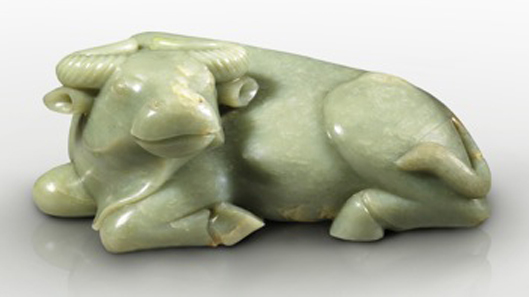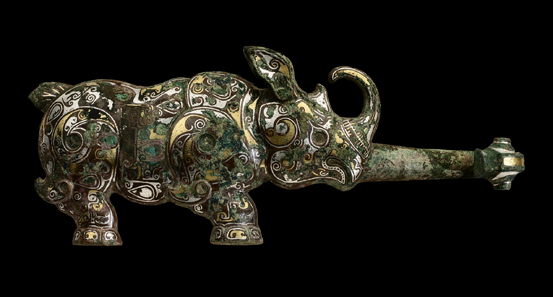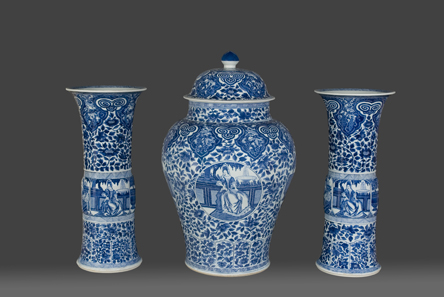March 22, 2012 – China has overtaken the United States as the world’s biggest market for art and antiques ending decades of American domination. This historic turning point, which is also an important indicator of seismic shifts in the wider global economy, is revealed in a new report published on Friday 16 March 2012.
In China power and wealth is associated with the buffalo. This exceptionally fine jade figure was exhibited at TEFAF Maastricht 2012 by Priestley & Ferraro from London.
The International Art Market in 2011: Observations on the Art Trade over 25 Years has been commissioned by TEFAF Maastricht, the world’s best art and antiques fair.
China’s share of the global art market rose from 23% in 2010 to 30% last year, pushing the United States, with 29%, into second place. The report, compiled by Dr Clare McAndrew, a cultural economist specialising in the fine and decorative art market and founder of Arts Economics, called the development “perhaps one of the most fundamental and important changes in the last 50 years”. The United Kingdom, which was overtaken by China in 2010, remained third with a 22% market share while France was a distant fourth with 6%.
Daigou shaped like a rhinoceros. Bronze, silver and Gold, 481-221. Exhibited at TEFAF Maastricht 2012 by Gisèle Croes. Photo: Studio Roger Asselberghs – Frédéric Dehaen.
The powerful surge by China combined with a rise in fine art sales, particularly in the Modern and Contemporary sectors, led to a continuing strengthening in the art and antiques market worldwide. Sales in 2011 rose by 7% to 46.1 billion euros, an increase of 63% from the market crisis of 2009. Although not quite back to its 2007 pre-recession high of 48.1 billion euros, the market has staged a significant recovery over the past two years.
The principal findings of the report, the first TEFAF study of the market to be translated into Chinese, are:
- China overtook the US for the first time in 2011 to become the largest art and antiques market worldwide with a share of 30% based on both auction and dealer sales.
- The US share dropped by 5 percentage points to 29% while the combined total for the 27 European Union countries was also down by 3 percentage points to 34%. Among the EU nations, the largest markets were the UK with 22% of the global total and France with 6%, both unchanged.
Chinese porcellan (1662-1722) made for export. Exhibited at TEFAF Maastricht 2012 by Luis Alegria.
- The Chinese art and antiques auction sector was the strongest growing market worldwide with a dramatic rise of 177% in 2010 and a further 64% in 2011.
- The global art market continued to recover in 2011, increasing by 7% to €46.1 billion, an increase of 63% since the market crisis of 2009. The volume of transactions also increased by 5% to 36.8 million.
- The driving forces behind the recovery were strong sales in the Chinese auction market and the rise of fine art sales (over decorative art).
- The Modern and Contemporary sectors combined to account for nearly 70% of the fine art market. Both continued a strong recovery in 2011, leading them to levels in excess of the boom of 2007-2008.
- The art market took nearly a decade to recover from the recession of the 1990s whereas the contraction in 2009 has been relatively short-lived. This is due, in part, to its increasingly global nature.
- The art market has more than doubled in size in the 25 years since TEFAF Maastricht was founded and grew over 575% from its lowest point in 1991 (just under US$10 billion) to its highest in 2007 (US$66 billion / 48.1 billion euros).
“Apart from its rapid increase in size, the last decade has witnessed significant changes in the art market’s geographical distribution of sales,” writes Dr McAndrew in the report. “The next decade will be the first period when emerging market countries contribute more to global economic growth than developed ones.”
“The dominance of the Chinese market has been driven by expanding wealth, strong domestic supply and the investive drive of Chinese art buyers. Although recent economic turmoil has created a more cautious buying climate in the rest of the world, growing domestic difficulties in Chinese property and stock markets and the lack of other alternatives appear to have led to a significant amount of substitution into art as an investment by Chinese consumers.”
“However all regions will be facing challenges in 2012 and beyond: the Chinese art market in how to cope with an overheated market and promote more stable, long-term growth; Europe, with how to maintain its competitiveness in the face of continued regulatory and cost burdens: and the US, with the challenge of losing its supremacy during the recent past as the centre for demand and supply in the market.”
Copies of the TEFAF report can be ordered at 25 euros (except shipping costs) on the TEFAF website (shop).







